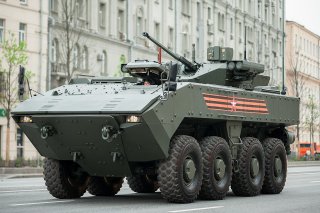Can Russia's K-17 Take On the Optionally Manned Fighting Vehicle?
It would seem unlikely that a new Russian Infantry Fighting Vehicle could truly rival the yet-to-emerge U.S. Army Bradley replacement, the Optionally Manned Fighting Vehicle.
Here's What You Need to Remember: While much of the technological specifics of the Army’s new OMFV are yet to be determined as the Army is now evaluating industry proposals and preparing for the next phase in an ongoing competition among vehicle-builders to make prototypes and offer new technologies to the Army. Is Russia trying to leap ahead of the U.S. Army’s now evolving new infantry carrier? It could be possible, however the relative technological sophistication and weapons performance capacity of a new soon-to-be-unveiled Russian infantry fighting vehicle are yet unknown. TASS news agency reported that Russia's state-owned weapons maker will demonstrate its latest Bumerang infantry fighting vehicle for the first time at an upcoming MILEX 2021 arms show in Belarus. Perhaps it is a new variant of the Bumerang, the latest version of which was a wheeled armored platform used to develop the K-17 wheeled infantry fighting vehicle, TASS reports. “The K-17 infantry fighting vehicle’s baseline version is outfitted with the Epokha combat module with a 30 mm automatic gun and a coaxial 7.62 mm machine-gun and the Kornet anti-tank missile system. The K-16 armored personnel carrier is armed with a combat module with a 12.7 mm machine-gun,” TASS reports. As an adaptation or upgrade to existing technology, it would seem unlikely that a new Russian Infantry Fighting Vehicle could truly rival the yet-to-emerge U.S. Army Bradley replacement, the Optionally Manned Fighting Vehicle. While in its nascent phase, the emerging OMFV is now the focus of a current U.S.-Army led competition among industry vendors to engineer a capable armored combat vehicle with a wide sphere of new technical attributes to include an ability to launch drones, deliver infantry under hostile file, conduct forward surveillance, network with robots and operate either manned or unmanned as dictated by mission requirements. While much of the technological specifics of the Army’s new OMFV are yet to be determined as the Army is now evaluating industry proposals and preparing for the next phase in an ongoing competition among vehicle-builders to make prototypes and offer new technologies to the Army. Given this, it would not seem likely that a Russian armored vehicle upgrade would outpace some of the innovations expected with the U.S. Bradley replacement in terms of combat performance, however much is said about the many merits of the Russian-engineered T-14 Armata tank. The developmental strategy for the OMFV is to engineer something upgradeable for the long term such that it can remain competitive or even superior in future threat environments years from now, yet also produce something with near-term benefits in terms of survivability, computing, manned-unmanned teaming, and weapons capacity. In this respect, there could potentially be some parallels in terms of mission scope between the Russian Bumerang variant and the evolving OMFV. However, the OMFV is still many years from being fully operational as it is only now about to enter a new developmental testing phase. Kris Osborn is the Defense Editor for the National Interest. Osborn previously served at the Pentagon as a Highly Qualified Expert with the Office of the Assistant Secretary of the Army—Acquisition, Logistics & Technology. Osborn has also worked as an anchor and on-air military specialist at national TV networks. He has appeared as a guest military expert on Fox News, MSNBC, The Military Channel, and The History Channel. He also has a Master's Degree in Comparative Literature from Columbia University. This article is being republished due to reader interest. Image: Reuters.

